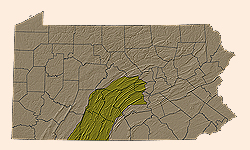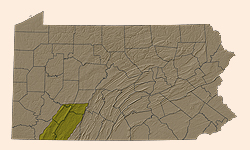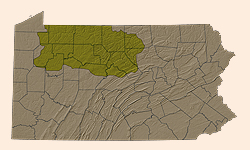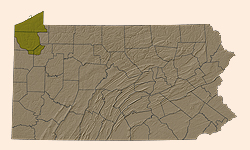Key Protection Areas

Central Valleys and Ridges
The Central Valleys and Ridges provide unforgettable views of long, forested mountain ridges and picturesque rural valleys. Encompassing Pennsylvania’s Potomac River tributaries, the Juniata River basin and the Nittany Valley, this region is the source of a significant amount of the water that flows into the Chesapeake Bay.
WPC has helped conserve more than 20,000 acres that have become additions to state forests, game lands and parks. It has improved water quality in local watersheds such as Sideling Hill Creek, Yellow Creek, Spruce Creek and Cove Creek by working with conservation groups, farmers and landowners.

Laurel Highlands
The Laurel Highlands is known for its mountains, valleys, streams and critical farmland. Since 1951, WPC has protected more than 80,000 acres in this area, including conserving much of the land that is now Ohiopyle State Park, Roaring Run Natural Area and Quebec Run Wild Area.
WPC owns and manages the Bear Run Nature Reserve around Fallingwater and has protected nearly 9,000 acres of farmland and woodlands in the Ligonier Valley.
WPC’s watershed initiatives have restored streams and rivers impacted by abandoned mine drainage and have reduced erosion and sediment pollution. WPC has also developed watershed conservation plans for communities.

Northern Woods
Pennsylvania’s Northern Woods contains some of the largest expanses of forestland in the eastern United States. They harbor black bear, elk and hundreds of miles of trout-rich wilderness streams. Situated at the headwaters of the Allegheny and Susquehanna rivers, the forests protect sources of drinking water for millions of people.
WPC has conserved nearly 100,000 acres in this region, including parcels along the Clarion, Allegheny and West Branch Susquehanna river systems. Working with grassroots conservation organizations, it has protected healthy waterways and has restored damaged ones. The Clarion River, for example, has become an outdoor destination and a key economic contributor to the region.

French Creek and Lake Erie Shoreline
French Creek is a tributary to the Allegheny River, an ecologically significant waterway and home to endangered and rare fish, mussels and plants. The Lake Erie Shoreline is home to rare species, as well as a recreational hotspot that is vital to the local economy.
WPC has conserved more than 6,740 acres in the French Creek watershed and along the Lake Erie Shoreline. It has protected and restored floodplains and wetlands, including the land surrounding Lake Pleasant, Wattsburg Fen natural area and the French Creek flood plain. WPC also helped conserve the David M. Roderick Wildlife Reserve and Erie Bluffs State Park.
